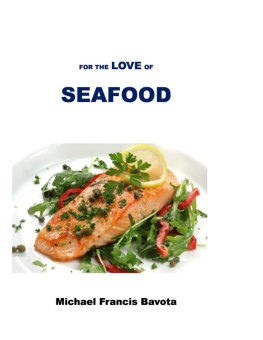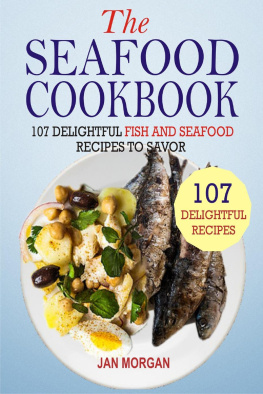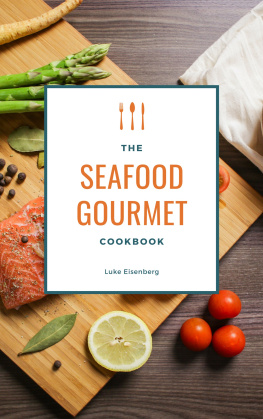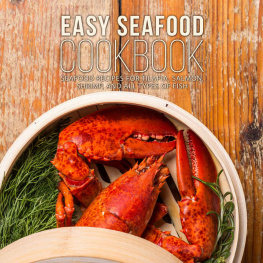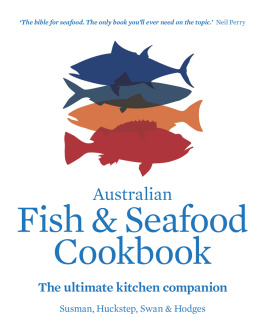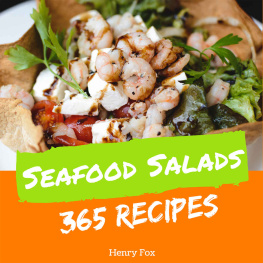Copyright 2007 by Michael F. Bavota
Published by Glenbridge Publishing Ltd.
19923 E. Long Ave. Centennial, Colorado 80016
All rights reserved. Except for brief quotations in critical articles or reviews, no part of this publication may be reproduced or transmitted in any form or by any means, electronic or mechanical, including photocopy, recording, or any information storage and retrieval system, without the prior written permission of the publisher.
FOREWORD
This enjoyable introduction to some of the world's greatest foods reveals the essential secrets for success in buying and cooking delicious, nutritious seafood. Designed for the average cook in any household from mothers and dads to bachelors to inspired teenage chefs it is based on popular, readily available seafood found in most neighborhood supermarkets.
Recipes include more than 200 seafood preparations, ranging from basic grilling, frying, baking to gourmet regional and international favorites. Although seafood is a popular item in restaurants, Americans eat very little of it at home. The reason is a lack of confidence. Many people do not know the basic secrets of buying and preparing delicious fish or shellfish.
This book will bring seafood and smiles back to American dinner tables. An important feature of For the Love of Seafood is the complete set of guidelines on buying fresh or frozen seafood. There are hints, facts, and cautions you are not likely to find anywhere else. This book also supplies information on the health impact of eating seafood as well as entertaining lore on popular types of fish and shellfish used in the recipes. After you have mastered these simple and reliable cooking methods, you will be ready to attempt other restaurant quality gourmet seafood dishes.
As a forty-year veteran in the seafood business, I can tell you that I have seen a lot. In 1970, when I began my career, the United States Seafood Per Capita Consumption was just 11.2 pounds. To put this statistic into perspective, the current statistics released for 2011 puts the U.S. Per Capita Consumption at 15.0 pounds with the record being 16.6 pounds in 2004. Compare that to Japans declining consumption of seafood in 2011 at 123.3 pounds, and one could say that the U.S. consumes little seafood. It is also interesting to note that China is the leading producer of seafood in the world.
When asked the reasons why consumers in the U.S. eat less seafood than other food groups, the overwhelming reply is fear of cooking. The pure and simple truth is that seafood is expensive, and if not cooked successfully in the home, the household food dollar can be sacrificed for a less than enjoyable meal. In this cookbook you will learn how to easily and successfully prepare good seafood in the home. All of the seafood recipes have been specifically designed to be simple enough for any average cook in the household, from mom, to bachelor, to an inspired teen chef. All of the recipes in this book require minimal investment in cooking gear and ingredients. The seafood can be found in most neighborhood supermarkets. The recipes are not modeled after award winning five-star restaurant menus, but rather to satisfy your family, your guests, and to look great on your dinner table. Each meal is quick and full of wonderful flavor.
One of the best-kept secrets about cooking seafood is that most consumers tend to overcook the product. Purely out of habit, most home cooks treat seafood as if it were beef, chicken, or pork. Mom taught most of us to cook, and she warned that meat must be cooked well-done to avoid getting sick. Quite honestly, Mom knew how to cook a roast or a nice chop, but when it came to seafood, even she at times was unsure. The key to preparing seafood successfully in your home is to develop a proper timing for cooking seafood. A simple seafood-cooking rule for all methods of cooking seafood is the Canadian Cooking Rule (10 minutes per inch of thickness). (See Chapter 1- Rules of Cooking.)
Seafood is grouped into two basic classifications: FINFISH: whole fish, steak fish, fillet SHELLFISH:
Crustaceans: (external skeleton, jointed legs) crab, crawfish, lobster, and shrimp.
Mollusk: (bi-valve, two shells, filter feeder) clams, mussels, oysters, and scallops.
This book is broken down in easy species categories, beginning with everyones favorite: shrimp, crab, lobster, scallops (Chapters 2-5). Most people like the sweet, delicate taste of shrimp. Each shrimp recipe has been carefully designed to help you to build an exciting, crowd-pleasing repertoire of basic to moderate to more elegant gourmet shrimp dishes. As you work through the first few dishes, and begin to get a good feel for shrimp, the challenges of the last recipes become easier to perfect.
Then it is on to the finfish, with the cholesterol reducing Omega 3s found in fresh Salmon (Chapter 6-7). You will next move on to Tuna (Chapter 8), and the exotic Tropical Island Favorites: Mahi-mahi, Wahoo, and Snapper (Chapter 9).
Next I talk about Cod, Flounder, Grouper, Shellfish, Imitation Crab Salads, and all-time summer grill favorites: Swordfish and Halibut (Chapters 10-15).
In each species category you will find that the first recipe is the easiest. The cooking method that has been selected to lead the category helps you to get a good feel for proper timing of the cooking. The recipes give easy instructions to help you to look, smell, and feel what is right and what is wrong, before you ruin a good meal.
At the beginning of each new category I will tell you some interesting background information on the fish you will be preparing. You will see examples of the different types of products in a group (Crab: Blue Crab, Snow Crab, King Crab, Stone Crab, and Dungeness crab). Where needed, I will show you an easy cleaning method or preparation for cooking method. Then it will be your turn to cook and learn. These recipes will teach you how to work with each product successfully. Once you have mastered the recipes in my book, you will be able to pick up any cookbook and have great success with seafood. You will know what to look for when buying seafood.
I know that by using this cookbook often you will become the best seafood cook in your neighborhood. Then do your heart a favorEAT MORE SEAFOOD.
TABLE OF CONTENTS
Global Resource Consumption Stats
Aquaculture Farm-Raised Where to Buy
Good Seafood Quality/Freshness
Chart of Freshness
Fresh vs. Frozen and Misperceptions of Frozen
Is it Safe?
Basic Rules of Cooking
Types (species) of Shrimp Farm-Raised Shrimp
Sizes and U.S. Grade Chart How to Peel & Devein
RECIPES:
Basic Peel & Eat Steamed Shrimp (Maryland Style)
Basic Quick Boiled Shrimp (New Orleans Style) Easy Scampi to Die For
Fast and Easy Butterfly Shrimp Fry
Three Step Best Darn Chunky Shrimp Bisque Shrimp Creole
Chinese Shrimp and Broccoli
Bacon Wrapped BBQ Shrimp with Monterey Jack Cheese
Salt Pepper Shrimp from the Island of Palau
Perfect Holiday Cocktail Shrimp
Stuffed Baked Shrimp
Shrimp Tempura with Crunchy Veggies
Shrimpy Toast
Sweet & Sour Pepper Shrimp
Sesame Honey BBQ Shrimp
Easy Shrimp Pizza with Mushrooms
Blackened Shrimp
Grilled BBQ Peel & Eat Shrimp
Mediterranean Shrimp Medley
Spicy Shrimp Fajita
Hibachi Shrimp Teriyaki with Vegetables
Deep-fried Buffalo Shrimp
Holiday Shrimp Cocktail Tree
Types of Crabs
Cleaning and Picking
RECIPES:
Traditional Crab Cakes, Chesapeake Bay Style
Southern Spicy, Garlic, or BBQ Steamed Blue Crabs
Boiled Pacific Snow and King Crabs
Florida Stone Crab Claws, hot & buttery
Dungeness Crab California Style

